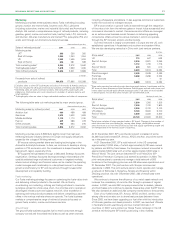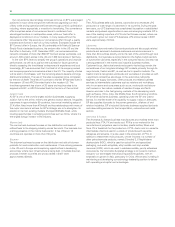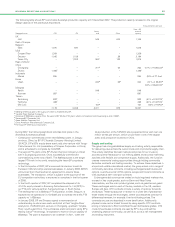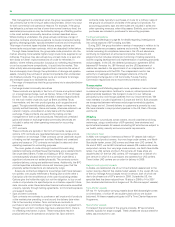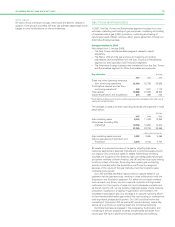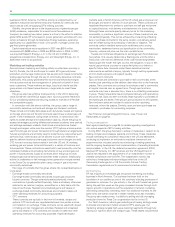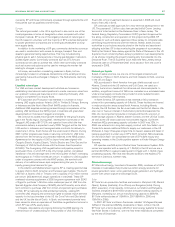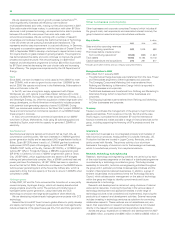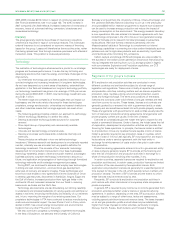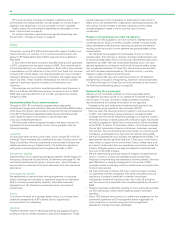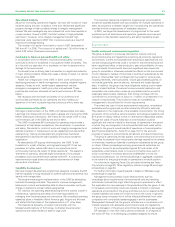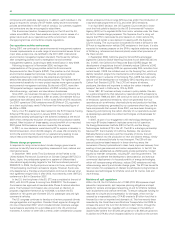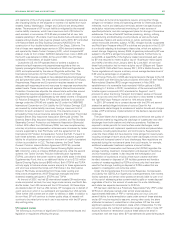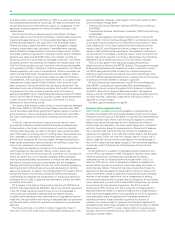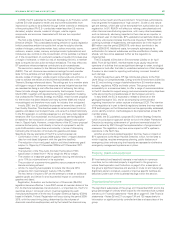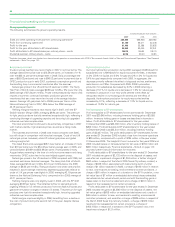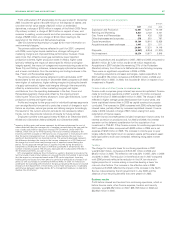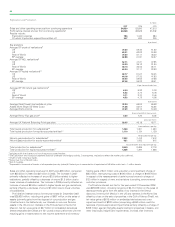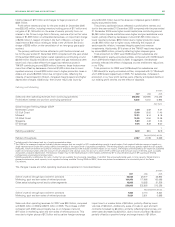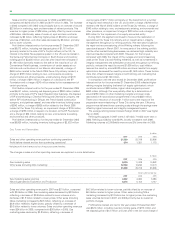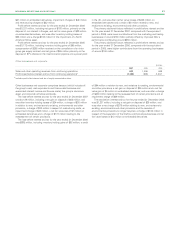BP 2007 Annual Report Download - page 43
Download and view the complete annual report
Please find page 43 of the 2007 BP annual report below. You can navigate through the pages in the report by either clicking on the pages listed below, or by using the keyword search tool below to find specific information within the annual report.
BP ANNUAL REPORT AND ACCOUNTS 2007 41
Operational integrity
As part of monitoring operational integrity, we track the number of major
incidents during the year: oil spills of more than 100 barrels, significant
property damage or fatal accidents related to integrity management
failures. We also investigate any near-misses that could have resulted in
a major incident. Overall in 2007, the total number of ‘high potentials’
went down; however, more integrity management-related ‘high
potentials’ were reported in 2007 than in previous years as a result of
improved knowledge-sharing.
Thenumberofoilspillsofonebarrelormorein2007decreasedto
340 from 417 in 2006. The volume of oil spilled was 1.05 million litres, of
which 0.33 million litres were unrecovered.
Continuing to focus on personal health and safety
In combination with our efforts to improve process safety, we have
continued to strive for excellence in occupational health and safety. This
is in line with our aspiration of no accidents, no harm to people and no
damage to the environment.
Continued focus on driving risks has resulted in a significant reduction
in major driving incidents, (those that cause a fatality or result in a vehicle
rollover) since 2005.
Health is an integral part of the OMS. In 2007, work continued on
developing practices in health management, covering industrial hygiene,
asbestos, fitness to work, health impact assessment, medical
emergency management, health promotion and wellness. These
practices set minimum standards of health performance in BP (see
below).
We recognize that the health and safety of our workforce and
communities is affected by our operations and that meeting our
aspiration of no harm to people requires continuous effort, every day.
Implementation of the OMS
We began implementation of the OMS at 12 representative pilot sites.
Learnings from these pilots will be used to assess and improve the OMS
before widening its introduction. We intend for the whole of BP to have
commmenced use of the OMS by the end of 2010.
The OMS incorporates BP’s principles for operating and provides a
framework to help deliver competence, then excellence, in operations
and safety. Standards for control of work and integrity management and
detailed ‘practices’ in matters such as risk assessment provide further
underpinning. Training and development programmes have been
strengthened to develop the right capability and culture across the
organization.
As described by BP’s group chief executive, the OMS ‘‘is the
foundation for a safe, effective, and high-performing BP. It has two
purposes: to further reduce HSE risks in our operations and to
continuously improve the quality of those operations’’. The system’s
‘elements of operating’ describe eight dimensions of how people,
processes, plant and performance operate within BP. A continuous
improvement process drives and sustains improvement of these
elements at a local level.
Capability development
We have initiated development programmes designed to ensure that BP
has the capability among its people to achieve operational excellence and
identify and manage risks.
The programmes support implementation of the OMS by developing
technical knowledge and skills. They seek to improve management,
behavioural, cultural and leadership skills to drive and sustain multi-year
change in operations across multiple geographies.
For instance, the operating essentials programme is tailored to staff in
maintenance, operations and safety who have responsibility for
managing front-line employees and contractors. We completed operating
essentials pilots in Anadarko (North America gas), Angola and Kwinana
and started the first phase of the implementation at 11 other sites.
The Operations Academy, provided in partnership with the
Massachusetts Institute of Technology, is directed towards senior
operations and safety leaders of sites or large units.
The executive operations programme targets group vice presidents
and senior business leaders with accountability for multiple operations or
sites. Its purpose is to deepen insight into manufacturing and operations
activities and the consequences of leadership decisions.
In 2007, we began the development of programmes for the wider
workforce such as technicians and operators, graduate new hires and
managers in roles between supervisory and senior leadership levels.
Environment
Health, safety and environmental regulation
The group is subject to numerous international, national and local
environmental laws and regulations concerning its products, operations
and activities. Current and proposed fuel and product specifications and
climate change programmes under a number of environmental laws will
have a significant effect on the production, sale and profitability of many
of our products. Environmental laws and regulations also require the
group to remediate or otherwise redress the effects on the environment
of prior disposal or release of chemicals or petroleum substances by the
group or other parties. Such contingencies may exist for various sites,
including refineries, chemicals plants, natural gas processing plants, oil
and natural gas fields, service stations, terminals and waste disposal
sites. In addition, the group may have obligations relating to prior asset
sales or closed facilities. Provisions for environmental restoration and
remediation are made when a clean-up is probable and the amount is
reasonably determinable. Generally, their timing coincides with the
commitment to a formal plan of action or, if earlier, on divestment or on
closure of inactive sites. The provisions made are considered by
management to be sufficient for known requirements.
The extent and cost of future environmental restoration, remediation
and abatement programmes are often inherently difficult to estimate.
They depend on the magnitude of any possible contamination, the timing
and extent of the corrective actions required, technological feasibility and
BP’s share of liability relative to that of other solvent responsible parties.
Though the costs of future restoration and remediation could be
significant and may be material to the results of operations in the period
in which they are recognized, it is not expected that such costs will be
material to the group’s overall results of operations or financial position.
See Financial statements – Note 37 on page 151 for the amounts
provided in respect of environmental remediation and decommissioning.
The group’s operations are also subject to environmental and common
law claims for personal injury and property damage caused by the release
of chemicals, hazardous materials or petroleum substances by the group
or others. Fifteen proceedings involving governmental authorities are
pending or known to be contemplated against BP and certain of its
subsidiaries under federal, state or local environmental laws, each of
which could result in monetary sanctions of $100,000 or more. No
individual proceeding is, nor are the proceedings in aggregate, expected
to be material to the group’s results of operations or financial position.
For information regarding Texas City and other refineries see Texas
City refinery on page 28, Other regulatory actions on page 29 and Legal
proceedings on page 84.
For further information regarding spills in Alaska in 2006 see Legal
proceedings on page 84.
Management cannot predict future developments, such as
increasingly strict requirements of environmental laws and resulting
enforcement policies that might affect the group’s operations or affect
the exploration for new reserves or the products sold by the group. A risk
of increased environmental costs and impacts is inherent in particular
operations and products of the group and there can be no assurance that
material liabilities and costs will not be incurred in the future. In general,
the group does not expect that it will be affected differently from other
companies with comparable assets engaged in similar businesses.
Management believes that the group’s activities are in compliance in all
material respects with applicable environmental laws and regulations.
For a discussion of the group’s environmental expenditure see page 53.
BP operates in more than 100 countries worldwide. In all regions of
the world, BP has, or is developing, processes designed to ensure


